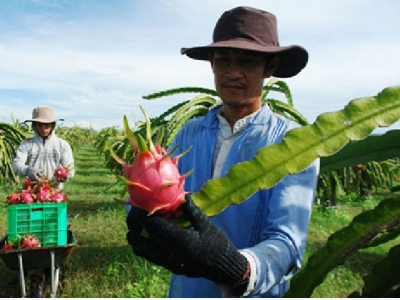US fruit growers look for pitaya market to take off in 2017

Exotic in looks and name, pitaya or strawberry pears, more commonly known as dragon fruit in Vietnam, are grown on trellising structures like those found in grape vineyards in the US and Mexico.
Farmers in the US state of Texas say the fruit is a domesticated version of a wild cactus that originated in Mexico and Central America and was transported to Asia by Catholic missionaries, where it acquired the dragon fruit label.
In the US only three states grow dragon fruit commercially: California (primarily Southern California), Florida, and Hawaii.
The fruit is primarily grown for the fresh market and is often sold through specialty stores and farmers’ markets and often sells at prices between US$14 and US$16 per kilo with organic prices reaching higher than US$50 per kilo wholesale and US$100 retail.
In addition, it has good potential to be processed into many products, thus adding value, including energy and fruit bars, ice cream, jelly, marmalade and preserves, juice, pastries, pulp, and yogurt.
The juice of the red varieties can also be used as a natural food colorant and dye, and, when unopened, the flower bud can be cooked and eaten as a vegetable, say US farmers.
It has been most common for dragon fruit to be sold in the agritourism segment in the US, where a commercial farm or ranch produces the fruit for the enjoyment and education of visitors and selling the fruit generates supplemental income.
But the marketplace is changing rapidly with US dragon fruit farmers actively educating local customers by performing store demos throughout the country in the large supermarket chains such as Krogers’ produce departments.
As a result of our marketing efforts to inform Texans of the health benefits of pitaya, Krogers in Houston is currently taking everything we can produce says one farmer and we don’t see that changing anytime soon
At local markets and in large stores, the farmer says he enjoys going one-on-one with consumers. I get the biggest kick from interacting with customers, he says and find their feedback motivating.
You’ve got to make your markets in the US. It’s an art. We beat the imported, tasteless fruit from Asian markets hands down in a taste test, across the US. Cultivating a good rapport with customers is the key to success in the US market, says the farmer, adding his farm is next looking to tap into the juice bar segment.
In 2016, the farmer says his farm harvested nearly seven metric ton of dragon fruit and aims to triple that amount in 2017 as more plants are maturing. He and his farm managers are also aiming to produce 11.33 kilograms of the tropical fruit per cactus plant.
Since dragon fruit is a newly emerging fruit crop, there is currently not a lot of export, import, or per capita consumption data available reported through the US Department of Agriculture’s Economic Research Service or Foreign Agricultural Service.
However, it is known that US farmers cannot meet the total demand for dragon fruit and it is imported from many other countries around the globe including but not limited to Nicaragua; Colombia; Ecuador; Vietnam; Thailand; Malaysia; and Israel.
Currently, Vietnam is in no position to compete in the US market, says Mai Kieu, director of the province of Binh Thuan Department of Agriculture and Rural Development.
This results from several reasons, the first being that farmers by and large fail to follow VietGAP safe food standards. Much of the problem results from the illiteracy rate of farmers who fail to appreciate the importance of producing certifiably safe food.
As a result, more than 70% of the dragon fruit of the province, the largest growing area in Vietnam, can only be sold in China, which has no food safety requirements to speak of, and most is sold in the informal market at extremely low prices or left to rot in the fields.
Local Phan Thiet packing company Binh Loan says that in the low season, it receives on average five to six tons of dragon fruit per day from neighbouring farms, while in the high season from May through to August, it receives between 20 to 30 tons per day depending on the harvest.
All their produce is destined for the fruit bowls of kitchens in China. The company pays farmers between US$.88-US$.97 (VND20,000-VND22,000) per kilo. In some fruit shops in Ho Chi Minh City, dragon fruit retails for around US$1.45 (VND33,000) per kilo.
Related news
 Vietnam’s northern province to export mangoes to Australia
Vietnam’s northern province to export mangoes to Australia Vietnam’s northern province of Son La will export mangoes to Australia for the first time in May
 Myanmar to export 18 tonnes of coffee beans to the United States in 2017
Myanmar to export 18 tonnes of coffee beans to the United States in 2017 Myanmar will export 18 tonnes of coffee seed to the US this fiscal year. The price of Myanmar coffee seed has recently increased in Europe and US markets.
 State Bank to aid pig farmers
State Bank to aid pig farmers The State Bank of Vietnam (SBV) issued an official document asking credit institutions to support borrowers in the livestock industry